中秋节的来历英文版
中秋节的来历英文带翻译
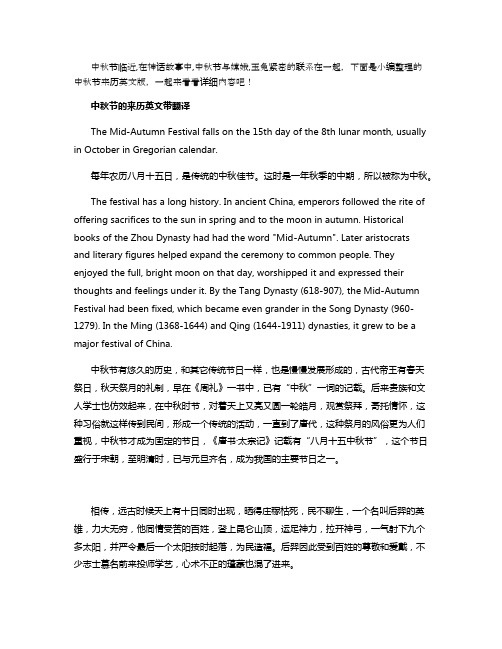
中秋节临近,在神话故事中,中秋节与嫦娥,玉兔紧密的联系在一起,下面是小编整理的中秋节来历英文版,一起来看看详细内容吧!中秋节的来历英文带翻译The Mid-Autumn Festival falls on the 15th day of the 8th lunar month, usually in October in Gregorian calendar.每年农历八月十五日,是传统的中秋佳节。
这时是一年秋季的中期,所以被称为中秋。
The festival has a long history. In ancient China, emperors followed the rite of offering sacrifices to the sun in spring and to the moon in autumn. Historical books of the Zhou Dynasty had had the word "Mid-Autumn". Later aristocratsand literary figures helped expand the ceremony to common people. They enjoyed the full, bright moon on that day, worshipped it and expressed their thoughts and feelings under it. By the Tang Dynasty (618-907), the Mid-Autumn Festival had been fixed, which became even grander in the Song Dynasty (960-1279). In the Ming (1368-1644) and Qing (1644-1911) dynasties, it grew to be a major festival of China.中秋节有悠久的历史,和其它传统节日一样,也是慢慢发展形成的,古代帝王有春天祭日,秋天祭月的礼制,早在《周礼》一书中,已有“中秋”一词的记载。
传统节日中秋节介绍英文版ppt课件

The origin of the Mid-Autumn Festival 中秋起源
In the Northern Song Dynasty (960–1127 AD), the 15th day of the 8th lunar month was established as the "Mid-Autumn Festival". From then on, sacrificing to the moon was very popular, and has become a custom ever since.
中秋节有三千多年历史,可以追溯到商代时对月亮的崇拜。因为中秋节 的重要地位,历代诗人都会为中秋节写诗,关于中秋节的故事、传奇在 民间广为流传,中秋节的起源也被历代中国人探究。
The origin of the Mid-Autumn Festival 中秋起源
The term "Mid-Autumn" first appeared in the book Rites of Zhou (周礼), written in the Warring States Period (475–221 BC). But the term only related to the time and season; the festival didn't exist at that point. “中秋”一词最早出现在战国时期《周礼》一书中,但是该词只和时间和季节有关,当时还没有中秋节。 In the Tang Dynasty (618–907 AD), it was popular to appreciate the moon. Many poets liked to create poems related to the moon when appreciating it. There is a legend that Emperor Xuanzong of the Tang Dynasty visited the Moon Palace in his dream and heard a wonderful song.
中秋节来历英文版
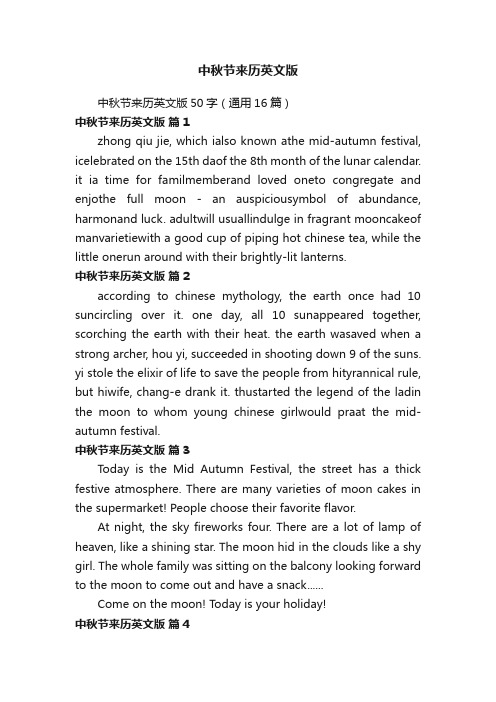
中秋节来历英文版中秋节来历英文版50字(通用16篇)中秋节来历英文版篇1zhong qiu jie, which ialso known athe mid-autumn festival, icelebrated on the 15th daof the 8th month of the lunar calendar. it ia time for familmemberand loved oneto congregate and enjothe full moon - an auspiciousymbol of abundance, harmonand luck. adultwill usuallindulge in fragrant mooncakeof manvarietiewith a good cup of piping hot chinese tea, while the little onerun around with their brightly-lit lanterns.中秋节来历英文版篇2according to chinese mythology, the earth once had 10 suncircling over it. one day, all 10 sunappeared together, scorching the earth with their heat. the earth wasaved when a strong archer, hou yi, succeeded in shooting down 9 of the suns. yi stole the elixir of life to save the people from hityrannical rule, but hiwife, chang-e drank it. thustarted the legend of the ladin the moon to whom young chinese girlwould praat the mid-autumn festival.中秋节来历英文版篇3Today is the Mid Autumn Festival, the street has a thick festive atmosphere. There are many varieties of moon cakes in the supermarket! People choose their favorite flavor.At night, the sky fireworks four. There are a lot of lamp of heaven, like a shining star. The moon hid in the clouds like a shy girl. The whole family was sitting on the balcony looking forward to the moon to come out and have a snack......Come on the moon! Today is your holiday!中秋节来历英文版篇4Today, it's the Mid Autumn Festival. After dinner, I go upstairs to see the moon and look up. Ah! The blue sky hangs a big round moon, like a large white jade plate, white light on the earth. Large plate has a shadow, that is, the goddess of the moon and moon osmanthus tree. Do you really have the Chang'e and the jade rabbit in the moon? I really want to know how I want to sit on the spaceship and fly to the moon to see them!中秋节来历英文版篇5The Mid Autumn Festival is a traditional festival in China, a full moon means reunion, originally we were going to go to the seaside to celebrate, but because my grandmother was ill in hospital, mom and dad busy, so we had to go to the seaside, only in their own community tours in August fifteen month, the moon is really big and round, golden moon hanging on the air is so bright, so happy, I made a wish on the moon, is the hope of grandma early disease, the body has been healthy.中秋节来历英文版篇6Today is the Mid Autumn Festival, it is the day of family reunion.Our district held a mid autumn festival, a rich program on the stage, singing and dancing is very lively, and lucky draw, mother said thousands of people, don't smoke to us, we watch the show happy, suddenly heard the table read my father's name, we are a family of three stunned he stood there, I loudly said dad won, dad happy to accept the award, today is really a lucky day.中秋节来历英文版篇7in the 14th century, the eating of mooncakeat zhong qiu jie wagiven a new significance. the storgoethat when zhu yuan zhang waplotting to overthrow the yuan dynaststarted bthe mongolians, the rebelhid their messagein the mid-autumnmooncakes. zhong qiu jie ihence also a commemoration of the overthrow of the mongolianbthe han people.中秋节来历英文版篇8during the yuan dynast(a.d.1206-1368) china waruled bthe mongolian people. leaderfrom the preceding sung dynast(a.d.960-1279) were unhappat submitting to foreign rule, and set how to coordinate the rebellion without it being discovered. the leaderof the rebellion, knowing that the moon festival wadrawing near, ordered the making of special cakes. packed into each mooncake waa message with the outline of the attack. on the night of the moon festival, the rebelsuccessfullattacked and overthrew the government. what followed wathe establishment of the ming dynast(a.d. 1368-1644). today, moon cakeare eaten to commemorate thievent.中秋节来历英文版篇9"Zhong Qiu Jie", which is also known as the Mid-Autumn Festival, is celebrated on the 15th day of the 8th month of the lunar calendar. It is a time for family members and loved ones to congregate and enjoy the full moon - an auspicious symbol of abundance, harmony and luck. Adults will usually indulge in fragrant mooncakes of many varieties with a good cup of piping hot Chinese tea, while the little ones run around with their brightly-lit lanterns."Zhong Qiu Jie" probably began as a harvest festival. The festival was later given a mythological flavour with legends of Chang-E, the beautiful lady in the moon.According to Chinese mythology, the earth once had 10 suns circling over it. One day, all 10 suns appeared together, scorching the earth with their heat. The earth was saved when a strong archer, Hou Yi, succeeded in shooting down 9 of the suns. Yi stolethe elixir of life to save the people from his tyrannical rule, but his wife, Chang-E drank it. Thus started the legend of the lady in the moon to whom young Chinese girls would pray at the Mid-Autumn Festival.In the 14th century, the eating of mooncakes at "Zhong Qiu Jie" was given a new significance. The story goes that when Zhu Yuan Zhang was plotting to overthrow the Yuan Dynasty started by the Mongolians, the rebels hid their messages in the Mid-Autumn mooncakes. Zhong Qiu Jie is hence also a commemoration of the overthrow of the Mongolians by the Han people.During the Yuan Dynasty (A.D.1206-1368) China was ruled by the Mongolian people. Leaders from the preceding Sung Dynasty(A.D.960-1279) were unhappy at submitting to foreign rule, and set how to coordinate the rebellion without it being discovered. The leaders of the rebellion, knowing that the Moon Festival was drawing near, ordered the making of special cakes. Packed into each mooncake was a message with the outline of the attack. On the night of the Moon Festival, the rebels successfully attacked and overthrew the government. What followed was the establishment of the Ming Dynasty (A.D. 1368-1644). Today, moon cakes are eaten to commemorate this event.Mid-Autumn Day is a traditional festival in China. Almost everyone likes to eat mooncakes on that day. Most families have a dinner together to celebrate the festival. saying goes, "The moon in your hometown is almost always the brightest and roundest". Many people who live far away from homes want to go back to have a family reunion. How happy it is to enjoy the moon cakes while watching the full moon with your family members.中秋节来历英文版篇10The Mid-Autumn is a very important Chinese festival.It falls on the 15th day of August.A few days before the festival,everyone in the family will help to make the house clean and nterns will be hung in front of the house.On the evening there will be a big family dinner.People who work far away from their homes will try to e back for the union.After dinner,people will light the lanterns which are usually red and round.Children will play with their own toy lanterns happily.At night the moon is usually round and bright.People can enjoy the moon while eating moon-cakes which are the special food for this festival.They can look back on the past and look forward to the future together.It is said that there was a dragon in the sky.The dragon wanted to swallow up the moon.T o protect the frighten the dragon away.中秋节是中国一个很重要的节日,在八月十五号.在节日来临的前几天,家庭中的每一个人都帮着打扫房子,把房子装扮得漂漂亮亮的`,灯笼挂在屋前.晚上有一顿美餐,离家在外工作的人也要回来团圆.晚饭后,人们点亮灯笼,一般是红色的圆灯笼.孩子们会高高兴兴地玩他们的玩具灯笼.晚上月亮又圆又大,人们在赏月的同时吃着中秋节特别的食品——月饼.人们在一起回顾过去,展望未来.据说天上有一条龙,它要把月亮吞下去.为了保护月亮,孩子们要弄出很大的响动把龙吓跑.中秋节来历英文版篇11August 15th in Chinese Lunar Calendar is the Mid-Autumn Day. It is one of the most important traditional festivals in China.On that day people usually go back home to have family reunion . Each family will have the members get together to have a big dinner. The most popular food is moon cakes. They are round and look like the moon.The moon is the brightest this night. People eat the deliciousfood while they are enjoying a beautiful full moon in their yard. At this time, some old people would like to tell many past events and tell the children a story about the rabbit on the moon. The children really believe that there is a rabbit on the moon. They hope to go to the moon and have a look one day.What a great festival!中秋节来历英文版篇12although honesty is believed to be a virtue, there are still dishonest people in our society。
中秋节来历英文(10篇)

中秋节来历英文(10篇)(经典版)编制人:__________________审核人:__________________审批人:__________________编制单位:__________________编制时间:____年____月____日序言下载提示:该文档是本店铺精心编制而成的,希望大家下载后,能够帮助大家解决实际问题。
文档下载后可定制修改,请根据实际需要进行调整和使用,谢谢!并且,本店铺为大家提供各种类型的经典范文,如合同协议、演讲致辞、述职报告、心得体会、工作总结、工作计划、自我鉴定、教学资料、作文大全、其他范文等等,想了解不同范文格式和写法,敬请关注!Download tips: This document is carefully compiled by this editor. I hope that after you download it, it can help you solve practical problems. The document can be customized and modified after downloading, please adjust and use it according to actual needs, thank you!Moreover, our store provides various types of classic sample essays, such as contract agreements, speeches, job reports, insights, work summaries, work plans, self-evaluation, teaching materials, complete essays, and other sample essays. If you want to learn about different sample formats and writing methods, please pay attention!中秋节来历英文(10篇)中秋节是中国最重要的节日之一。
中秋节的传说英文版
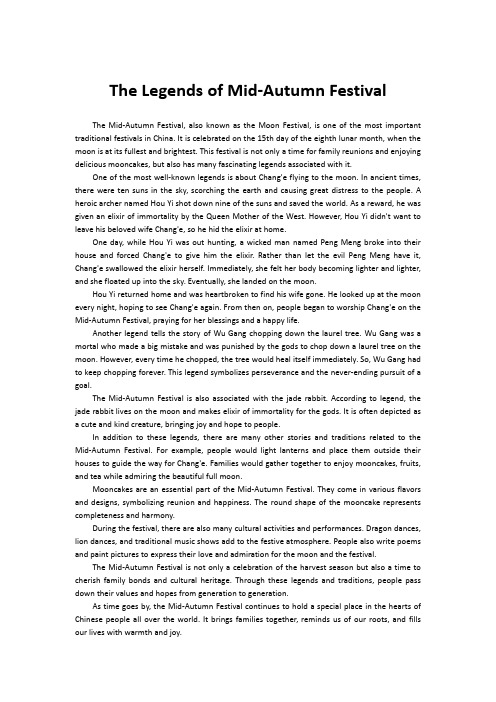
The Legends of Mid-Autumn Festival The Mid-Autumn Festival,also known as the Moon Festival,is one of the most important traditional festivals in China.It is celebrated on the15th day of the eighth lunar month,when the moon is at its fullest and brightest.This festival is not only a time for family reunions and enjoying delicious mooncakes,but also has many fascinating legends associated with it.One of the most well-known legends is about Chang'e flying to the moon.In ancient times, there were ten suns in the sky,scorching the earth and causing great distress to the people.A heroic archer named Hou Yi shot down nine of the suns and saved the world.As a reward,he was given an elixir of immortality by the Queen Mother of the West.However,Hou Yi didn't want to leave his beloved wife Chang'e,so he hid the elixir at home.One day,while Hou Yi was out hunting,a wicked man named Peng Meng broke into their house and forced Chang'e to give him the elixir.Rather than let the evil Peng Meng have it, Chang'e swallowed the elixir herself.Immediately,she felt her body becoming lighter and lighter, and she floated up into the sky.Eventually,she landed on the moon.Hou Yi returned home and was heartbroken to find his wife gone.He looked up at the moon every night,hoping to see Chang'e again.From then on,people began to worship Chang'e on the Mid-Autumn Festival,praying for her blessings and a happy life.Another legend tells the story of Wu Gang chopping down the laurel tree.Wu Gang was a mortal who made a big mistake and was punished by the gods to chop down a laurel tree on the moon.However,every time he chopped,the tree would heal itself immediately.So,Wu Gang had to keep chopping forever.This legend symbolizes perseverance and the never-ending pursuit of a goal.The Mid-Autumn Festival is also associated with the jade rabbit.According to legend,the jade rabbit lives on the moon and makes elixir of immortality for the gods.It is often depicted as a cute and kind creature,bringing joy and hope to people.In addition to these legends,there are many other stories and traditions related to the Mid-Autumn Festival.For example,people would light lanterns and place them outside their houses to guide the way for Chang'e.Families would gather together to enjoy mooncakes,fruits, and tea while admiring the beautiful full moon.Mooncakes are an essential part of the Mid-Autumn Festival.They come in various flavors and designs,symbolizing reunion and happiness.The round shape of the mooncake represents completeness and harmony.During the festival,there are also many cultural activities and performances.Dragon dances, lion dances,and traditional music shows add to the festive atmosphere.People also write poems and paint pictures to express their love and admiration for the moon and the festival.The Mid-Autumn Festival is not only a celebration of the harvest season but also a time to cherish family bonds and cultural heritage.Through these legends and traditions,people pass down their values and hopes from generation to generation.As time goes by,the Mid-Autumn Festival continues to hold a special place in the hearts of Chinese people all over the world.It brings families together,reminds us of our roots,and fills our lives with warmth and joy.Whether it's listening to the legends,enjoying mooncakes,or admiring the moon,the Mid-Autumn Festival is a time of wonder and beauty.It is a festival that connects us to our past, present,and future,and reminds us of the importance of love,family,and tradition.In modern times,the Mid-Autumn Festival has also taken on new meanings.It has become a time for people to relax and unwind from their busy lives.Many people take vacations during this period and spend time with their loved ones in beautiful scenic spots.The festival also promotes cultural exchanges and understanding.As more and more people around the world become interested in Chinese culture,the Mid-Autumn Festival is being celebrated in different countries and regions.This helps to spread Chinese traditions and values and build bridges between different cultures.Moreover,the Mid-Autumn Festival has inspired many artists and writers.Paintings, sculptures,novels,and movies have been created based on the legends and traditions of the festival.These works of art not only showcase the beauty of Chinese culture but also add to the richness and diversity of human civilization.As we celebrate the Mid-Autumn Festival year after year,we are reminded of the power of legends and traditions.These stories and customs have the ability to bring people together, inspire creativity,and pass on our cultural heritage.They are a precious part of our history and identity,and they will continue to shine brightly for generations to come.In conclusion,the Mid-Autumn Festival is a time of joy,reunion,and celebration.The legends associated with this festival add to its charm and mystery,making it a truly unique and special occasion.Whether you are with family,friends,or alone,take a moment to appreciate the beauty of the moon,savor the delicious mooncakes,and immerse yourself in the rich traditions of this wonderful festival.May the spirit of the Mid-Autumn Festival fill your life with love, happiness,and peace.。
英语故事,带翻译

三天后,后羿率众徒外出狩猎,心怀鬼胎的蓬蒙假装生病,留了下来。待后羿率众人走后不久,蓬蒙手持宝剑闯入内宅后院,威逼嫦娥交出不死药。嫦娥知道自己不是蓬蒙的对手,危急之时她当机立断,转身打开百宝匣,拿出不死药一口吞了下去。嫦娥吞下药,身子立时向天上飞去。由于嫦娥牵挂着丈夫,便飞落到离人间最近的月亮上成了仙
根据史籍的记载,“中秋”一词最早出现在《周礼》一书中。到魏晋时,有“谕尚书镇牛淆,中秋夕与左右微服泛江”的记载。直到唐朝初年,中秋节才成为固定的节日。《唐书·太宗记》记载有“八月十五中秋节”。中秋节的盛行始于宋朝,至明清时,已与元旦齐名,成为我国的主要节日之一。这也是我国仅次于春节的第二大传统节日。
中秋节起源的另一个说法是:农历八月十五这一天恰好是稻子成熟的时刻,各家都拜土地神。中秋可能就是秋报的遗俗。
中秋节的传说
中秋节的传说是非常丰富的,嫦娥奔月、吴刚伐桂、玉兔捣药之类的神话故事流传甚广。
嫦娥奔月
相传,远古一个名叫后羿的英雄,射下九个太阳,并严令最后一个太阳按时起落,为民造福。后羿因此受到百姓的尊敬和爱戴,娶了个美丽善良的妻子,名叫嫦娥。后羿除传艺狩猎外,终日和妻子在一起,人们都羡慕这对郎才女貌的恩爱夫妻。不少志士也慕名前来投师学艺,心术不正的蓬蒙也混了进来。
(The Mid-Autumn Festival is a traditional festivity for both the Han and minority nationalities. The custom of worshipping the moon can be traced back as far as the ancient Xia and Shang Dynasties (2000 B.C.-1066 B.C.). In the Zhou Dynasty(1066 B.C.-221 B.C.), people hold ceremonies to greet winter and worship the moon whenever the Mid-Autumn Festival sets in. It becomes very prevalent in the Tang Dynasty(618-907 A.D.) that people enjoy and worship the full moon. In the Southern Song Dynasty (1127-1279 A.D.), however, people send round moon cakes to their relatives as gifts in expression of their best wishes of family reunion. When it becomes dark, they look up at the full silver moon or go sightseeing on lakes to celebrate the festival. Since the Ming (1368-1644 A.D. ) and Qing Dynasties (1644-1911A.D.), the custom of Mid-Autumn Festival celebration becomes unprecedented popular.) Together with the celebration there appear some special customs in different parts of the country, such as burning incense(熏香), planting Mid-Autumn trees, lighting lanterns on towers and fire dragon dances. However, the custom of playing under the moon is not so popular as it used to be nowadays, but it is not less popular to enjoy the bright silver moon. Whenever the festival sets in, people will look up at the full silver moon, drinking wine to celebrate their happy life or thinking of their relatives and friends far from home, and extending all of their best wishes to them.
中秋的由来 英文版
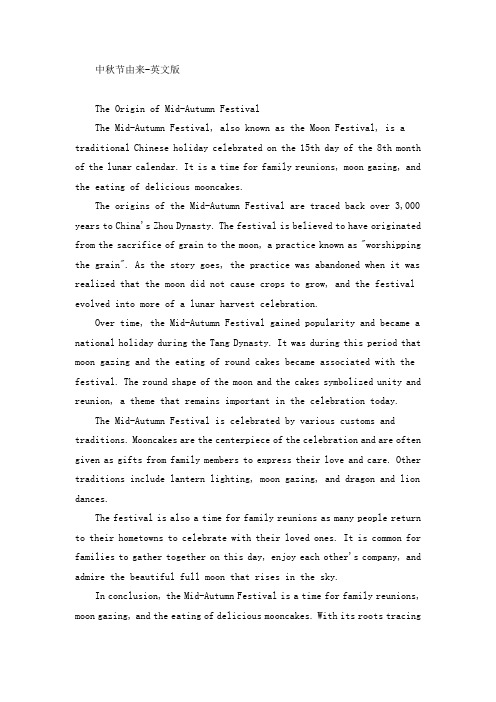
中秋节由来-英文版The Origin of Mid-Autumn FestivalThe Mid-Autumn Festival, also known as the Moon Festival, is a traditional Chinese holiday celebrated on the 15th day of the 8th month of the lunar calendar. It is a time for family reunions, moon gazing, and the eating of delicious mooncakes.The origins of the Mid-Autumn Festival are traced back over 3,000 years to China's Zhou Dynasty. The festival is believed to have originated from the sacrifice of grain to the moon, a practice known as "worshipping the grain". As the story goes, the practice was abandoned when it was realized that the moon did not cause crops to grow, and the festival evolved into more of a lunar harvest celebration.Over time, the Mid-Autumn Festival gained popularity and became a national holiday during the Tang Dynasty. It was during this period that moon gazing and the eating of round cakes became associated with the festival. The round shape of the moon and the cakes symbolized unity and reunion, a theme that remains important in the celebration today.The Mid-Autumn Festival is celebrated by various customs and traditions. Mooncakes are the centerpiece of the celebration and are often given as gifts from family members to express their love and care. Other traditions include lantern lighting, moon gazing, and dragon and lion dances.The festival is also a time for family reunions as many people return to their hometowns to celebrate with their loved ones. It is common for families to gather together on this day, enjoy each other's company, and admire the beautiful full moon that rises in the sky.In conclusion, the Mid-Autumn Festival is a time for family reunions, moon gazing, and the eating of delicious mooncakes. With its roots tracingback over 3,000 years, the festival has evolved into a traditional holiday that is celebrated throughout China and beyond. Its rich cultural history and meaningful traditions make it a cherished holiday that is passed down through generations.。
中秋节的来历和风俗英文作文
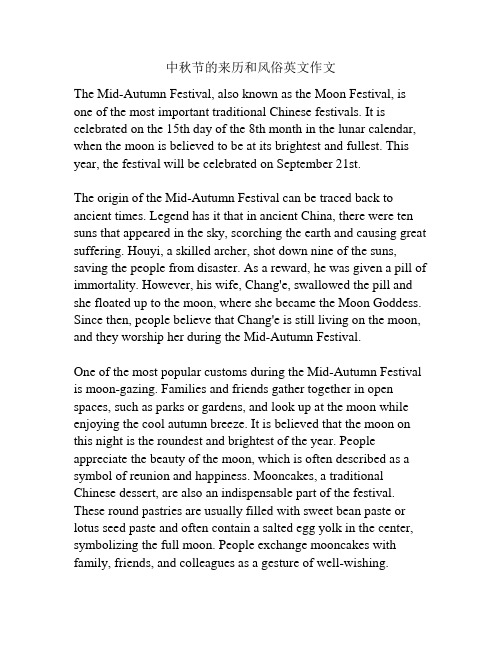
中秋节的来历和风俗英文作文The Mid-Autumn Festival, also known as the Moon Festival, is one of the most important traditional Chinese festivals. It is celebrated on the 15th day of the 8th month in the lunar calendar, when the moon is believed to be at its brightest and fullest. This year, the festival will be celebrated on September 21st.The origin of the Mid-Autumn Festival can be traced back to ancient times. Legend has it that in ancient China, there were ten suns that appeared in the sky, scorching the earth and causing great suffering. Houyi, a skilled archer, shot down nine of the suns, saving the people from disaster. As a reward, he was given a pill of immortality. However, his wife, Chang'e, swallowed the pill and she floated up to the moon, where she became the Moon Goddess. Since then, people believe that Chang'e is still living on the moon, and they worship her during the Mid-Autumn Festival.One of the most popular customs during the Mid-Autumn Festival is moon-gazing. Families and friends gather together in open spaces, such as parks or gardens, and look up at the moon while enjoying the cool autumn breeze. It is believed that the moon on this night is the roundest and brightest of the year. People appreciate the beauty of the moon, which is often described as a symbol of reunion and happiness. Mooncakes, a traditional Chinese dessert, are also an indispensable part of the festival. These round pastries are usually filled with sweet bean paste or lotus seed paste and often contain a salted egg yolk in the center, symbolizing the full moon. People exchange mooncakes with family, friends, and colleagues as a gesture of well-wishing.Another popular activity during the Mid-Autumn Festival is lantern-making. In the days leading up to the festival, children and adults alike decorate lanterns in various shapes and sizes. These lanterns are not only beautiful decorations but also provide a warm and festive atmosphere. Some lanterns are shaped like animals or plants, while others depict traditional Chinese symbols or characters. People carry the lanterns and walk around the neighborhood, creating a colorful and lively scene.Besides moon-gazing and lantern-making, the Mid-Autumn Festival is also a time for family reunion. Similar to Thanksgiving in Western culture, people travel long distances to be with their loved ones and share a festive dinner. The dinner usually consists of a variety of dishes, including traditional delicacies such as roast duck, steamed fish, and sticky rice dumplings. Family members sit around the table, enjoying the delicious food and chatting happily. In addition to eating, there are also various traditional games and activities that people can participate in, such as dragon and lion dances, riddle-solving, and even fire dragon dances.In conclusion, the Mid-Autumn Festival is a treasured cultural event in Chinese society. It is a time for family gatherings, moon-gazing, lantern-making, and sharing delicious food. It represents the beauty of reunion, the appreciation of nature, and the expression of gratitude. As the moon shines brightly on this special night, people embrace the warmth and happiness that the festival brings.。
关于中秋节的英文故事

关于中秋节的英文故事英文版中秋节的由来The Mid-Autumn FestivalThe Mid-Autumn is a very important Chinese festival. It falls on the 15th day of August. A few days before the festival, everyone in the family will help to make the house clean and beautiful. Lanterns will be hung in front of the house.On the evening there will be a big family dinner. People who work far away from their homes will try to come back for the union. After dinner, people will light the lanterns which are usually red and round. Children will play with their own toy lanterns happily.At night the moon is usually round and bright. People can enjoy the moon while eating moon-cakes which are the special food for this festival. They can look back on the past and look forward to the future together. It is said that there was a dragon in the sky. The dragon wanted to swallow up the moon. To protect the frighten the dragon away.中秋节中秋节是中国一个很重要的节日,在八月十五号。
中秋节的来历英语作文
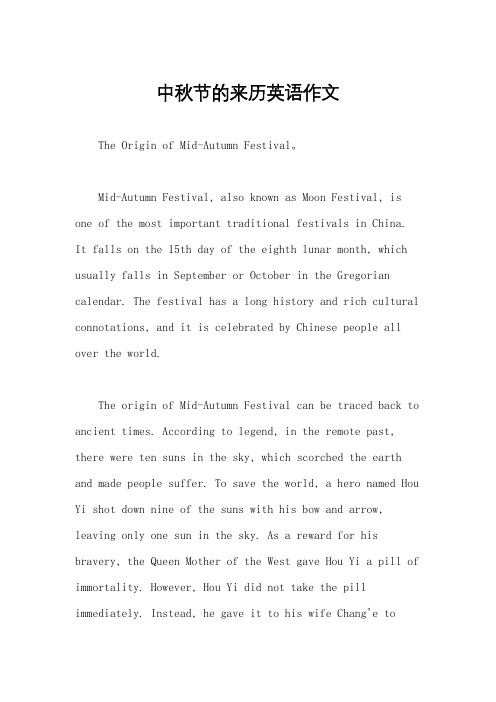
中秋节的来历英语作文The Origin of Mid-Autumn Festival。
Mid-Autumn Festival, also known as Moon Festival, is one of the most important traditional festivals in China.It falls on the 15th day of the eighth lunar month, which usually falls in September or October in the Gregorian calendar. The festival has a long history and rich cultural connotations, and it is celebrated by Chinese people all over the world.The origin of Mid-Autumn Festival can be traced back to ancient times. According to legend, in the remote past, there were ten suns in the sky, which scorched the earth and made people suffer. To save the world, a hero named Hou Yi shot down nine of the suns with his bow and arrow, leaving only one sun in the sky. As a reward for his bravery, the Queen Mother of the West gave Hou Yi a pill of immortality. However, Hou Yi did not take the pill immediately. Instead, he gave it to his wife Chang'e tokeep it safe. One day, while Hou Yi was out hunting, his apprentice Feng Meng broke into his house and tried tosteal the pill. In order to protect the pill, Chang'e swallowed it and flew to the moon. When Hou Yi returned home and found out what had happened, he was heartbroken and offered sacrifices to his wife on the night of the full moon, which is now known as Mid-Autumn Festival.The legend of Hou Yi and Chang'e is the most widely known story behind Mid-Autumn Festival, but there are many other stories and customs associated with the festival. For example, mooncakes are a traditional food eaten during the festival. They are round pastries with various fillings, such as lotus seed paste, red bean paste, and egg yolk, and are meant to symbolize the full moon. Eating mooncakes is a way for people to express their good wishes for family reunion and happiness. Another popular custom is to appreciate the moon and enjoy the moonlight. People often gather with their families and friends to watch the moon, recite poems, and play games.In addition to its cultural significance, Mid-AutumnFestival also has scientific implications. The festivalfalls on the day when the moon is at its fullest and brightest, which is a result of the relative positions ofthe moon, the earth, and the sun. During this time, the gravitational forces of the moon and the sun combine to create the highest tides of the year, known as "spring tides". The moon's gravitational pull also affects theearth's rotation, causing the length of a day to varyslightly over the course of a year.In conclusion, Mid-Autumn Festival is a time-honored tradition that reflects the rich cultural heritage of China. Its origins may be rooted in legend, but its customs and practices have been passed down from generation to generation, and continue to be cherished by Chinese people around the world. Whether it is through eating mooncakes, admiring the moon, or spending time with loved ones, the festival provides a meaningful opportunity for people to celebrate the joys of life and the beauty of nature.。
中秋节来历的故事英文版
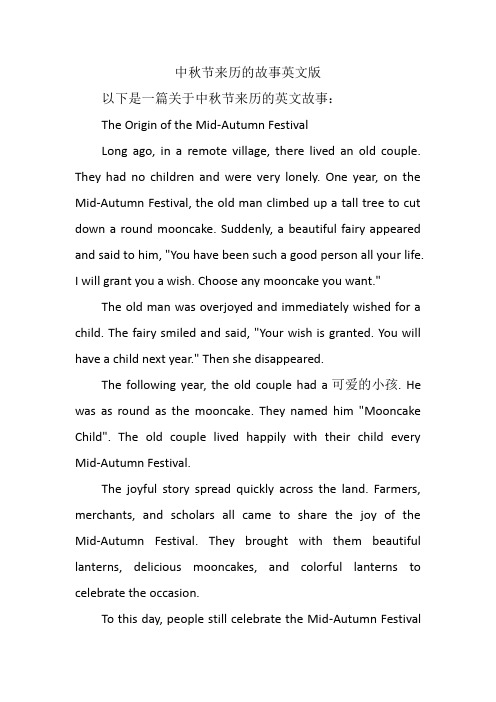
中秋节来历的故事英文版以下是一篇关于中秋节来历的英文故事:The Origin of the Mid-Autumn FestivalLong ago, in a remote village, there lived an old couple. They had no children and were very lonely. One year, on the Mid-Autumn Festival, the old man climbed up a tall tree to cut down a round mooncake. Suddenly, a beautiful fairy appeared and said to him, "You have been such a good person all your life.I will grant you a wish. Choose any mooncake you want."The old man was overjoyed and immediately wished for a child. The fairy smiled and said, "Your wish is granted. You will have a child next year." Then she disappeared.The following year, the old couple had a可爱的小孩. He was as round as the mooncake. They named him "Mooncake Child". The old couple lived happily with their child every Mid-Autumn Festival.The joyful story spread quickly across the land. Farmers, merchants, and scholars all came to share the joy of the Mid-Autumn Festival. They brought with them beautiful lanterns, delicious mooncakes, and colorful lanterns to celebrate the occasion.To this day, people still celebrate the Mid-Autumn Festivalwith beautiful lanterns, colorful dragon and lion dances, and tasty mooncakes to remember this happy story and to honor the love and kindness of the old couple.。
中秋节的来历和习俗英文

中秋节的来历和习俗英文中秋节的来历和习俗英文中秋节的来历和习俗英文(一)The joyous Mid-Autumn Festival was celebrated on the fifteenth day of the eighth moon, around the time of the autumn equinox(秋分). Many referred to it simply as the "Fifteenth of the Eighth Moon".农历8月15日是中国的中秋节,接近秋分时节。
很多人将中秋节简单的理解为与“8月15的月亮”相关。
This day was also considered as a harvest festival since fruits, vegetables and grain had been harvested by this time and food was abundant. Food offerings were placed on an altar set up in the courtyard. Apples, pears, peaches, grapes, pomegranates(石榴), melons, oranges and pomelos(柚子) might be seen. Special foods for the festival included moon cakes, cooked taro(芋头)and water caltrope(菱角), a type of water chestnut resembling black buffalo horns. Some people insisted that cooked taro be included because at the time of creation, taro was the first food discovered at night in the moonlight. Of all these foods, it could not be omitted from the Mid-Autumn Festival.The round moon cakes, measuring about three inches in diameter and one and a half inches in thickness, resembled Western fruitcakes in taste and consistency. These cakes were made with melon seeds(西瓜子), lotus seeds(莲籽), almonds(杏仁), minced meats, bean paste, orange peels and lard(猪油). A golden yolk(蛋黄) from a salted duck egg was placed at the center of each cake, and the golden brown crust was decorated with symbols of the festival. Traditionally, thirteen moon cakes werepiled in a pyramid to symbolize the thirteen moons of a "complete year," that is, twelve moons plus one intercalary(闰月的) moon. uUlsda EThe Mid-Autumn Festival is a traditional festivity for both the Han and minority nationalities. The custom of worshipping the moon can be traced back as far as the ancient Xia and Shang Dynasties (2000 B.C.-1066 B.C.). In the Zhou Dynasty(1066 B.C.-221 B.C.), people hold ceremonies to greet winter and worship the moon whenever the Mid-Autumn Festival sets in. It becomes very prevalent in the Tang Dynasty(618-907 A.D.) that people enjoy and worship the full moon. In the Southern Song Dynasty (1127-1279 A.D.), however, people send round moon cakes to their relatives as gifts in expression of their best wishes of family reunion. When it becomes dark, they look up at the full silver moon or go sightseeing on lakes to celebrate the festival. Since the Ming (1368-1644 A.D. ) and Qing Dynasties (1644-1911A.D.), the custom of Mid-Autumn Festival celebration becomes unprecedented popular. Together with the celebration there appear some special customs in different parts of the country, such as burning incense(熏香), planting Mid-Autumn trees, lighting lanterns on towers and fire dragon dances. However, the custom of playing under the moon is not so popular as it used to be nowadays, but it is not less popular to enjoy the bright silver moon. Whenever the festival sets in, people will look up at the full silver moon, drinking wine to celebrate their happy life or thinking of their relatives and friends far from home, and extending all of their best wishes to them.Moon Cakes月饼There is this story about the moon-cake. during the Yuan dynasty (A.D. 1280-1368) China was ruled by the Mongolianpeople. Leaders from the preceding Sung dynasty (A.D. 960-1280) were unhappy at submitting to the foreign rule, and set how to coordinate the rebellion without being discovered. The leaders of the rebellion, knowing that the Moon Festival was drawing near, ordered the making of special cakes. Backed into each moon cake was a message with the outline of the attack. On the night of the Moon Festival, the rebels successfully attached and overthrew the government. Today, moon cakes are eaten to commemorate this legend and was called the Moon Cake.For generations, moon cakes have been made with sweet fillings of nuts, mashed red beans, lotus-seed paste or Chinese dates(枣子), wrapped in a pastry. Sometimes a cooked egg yolk can be found in the middle of the rich tasting dessert. People compare moon cakes to the plum pudding and fruit cakes which are served in the English holiday seasons.中秋节的来历农历八月十五,是我国传统的中秋节,也是我国仅次于春节的第二大传统节日。
中秋节的来历介绍英文版
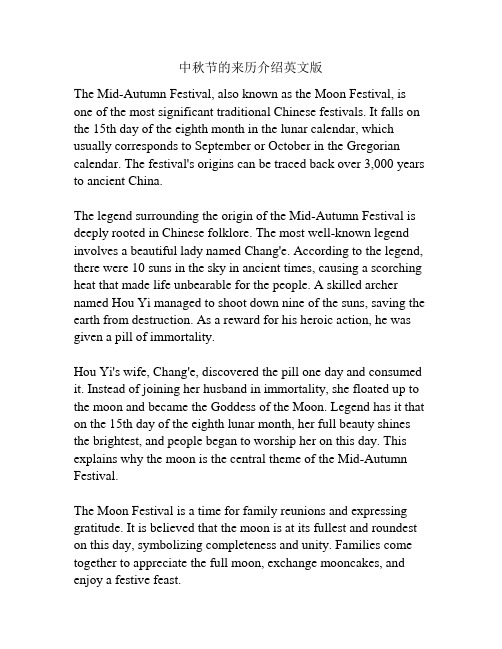
中秋节的来历介绍英文版The Mid-Autumn Festival, also known as the Moon Festival, is one of the most significant traditional Chinese festivals. It falls on the 15th day of the eighth month in the lunar calendar, which usually corresponds to September or October in the Gregorian calendar. The festival's origins can be traced back over 3,000 years to ancient China.The legend surrounding the origin of the Mid-Autumn Festival is deeply rooted in Chinese folklore. The most well-known legend involves a beautiful lady named Chang'e. According to the legend, there were 10 suns in the sky in ancient times, causing a scorching heat that made life unbearable for the people. A skilled archer named Hou Yi managed to shoot down nine of the suns, saving the earth from destruction. As a reward for his heroic action, he was given a pill of immortality.Hou Yi's wife, Chang'e, discovered the pill one day and consumed it. Instead of joining her husband in immortality, she floated up to the moon and became the Goddess of the Moon. Legend has it that on the 15th day of the eighth lunar month, her full beauty shines the brightest, and people began to worship her on this day. This explains why the moon is the central theme of the Mid-Autumn Festival.The Moon Festival is a time for family reunions and expressing gratitude. It is believed that the moon is at its fullest and roundest on this day, symbolizing completeness and unity. Families come together to appreciate the full moon, exchange mooncakes, and enjoy a festive feast.Mooncakes are a traditional delicacy during the Mid-Autumn Festival. They are circular pastries that come in a variety of flavors and fillings, such as lotus seed paste, red bean paste, and salted egg yolk. The round shape of the mooncake represents the full moon, while the stuffing inside symbolizes the reunion of family.In addition to mooncakes, other traditional activities are associated with the Mid-Autumn Festival. Lanterns are a common sight during this time, and children enjoy carrying lighted lanterns in various shapes and sizes. Some lanterns are crafted to resemble animals or mythical creatures. The lanterns add a vibrant and festive atmosphere to the celebration.Another popular activity during the Moon Festival is moon gazing. People gather outdoors, often in open parks or gardens, to appreciate the beauty of the moon. Some even compose poems or songs about the moon, expressing their emotions and desires.The tradition of the Mid-Autumn Festival has been passed down through generations, and it continues to be an important cultural event in China and other East Asian countries. It is a time for families to come together, celebrate their bonds, and pay homage to the moon. The festival's unique legends, delicious mooncakes, and enchanting lanterns all contribute to its enduring charm and popularity.。
中秋节的由来英文版

中秋节的由来英文版The Mid-Autumn Festival, also known as the Moon Festival, is a traditional Chinese festival that dates back over 3,000 years. Its origins are rooted in ancient Chinese folklore and mythology, and it is celebrated on the 15th day of the 8th month in the lunar calendar when the moon is at its fullest and brightest.One of the most well-known legends associated with the Mid-Autumn Festival is the story of Chang'e, the Moon Goddess. According to the legend, Chang'e swallowed anelixir of immortality and ascended to the moon, where she lives in eternal solitude. To commemorate her, people offer sacrifices and hold ceremonies during the Mid-Autumn Festival.Another popular legend is the tale of Hou Yi and the Ten Suns. It is said that Hou Yi, a skilled archer, shot down nine of the ten suns that were scorching the earth. As a reward, he was given an elixir of immortality. However,his wife, Chang'e, drank the elixir and ascended to the moon, becoming the Moon Goddess.In addition to these legends, the Mid-Autumn Festival is also a time for family reunions, moon gazing, and enjoying mooncakes, a traditional delicacy. The festival is a time for expressing gratitude, making wishes, and celebrating the harvest. It is a significant cultural event in Chinese tradition and is celebrated by Chinese communities around the world.。
中秋节的由来英语作文

中秋节的由来英语作文The Origin of Mid-Autumn Festival。
Mid-Autumn Festival, also known as the Moon Festival,is one of the most important traditional festivals in China. It falls on the 15th day of the eighth lunar month, which usually falls in September or early October. The festival has a long history and rich cultural significance, and is celebrated by Chinese people all over the world.The origin of Mid-Autumn Festival can be traced back to ancient times. According to legend, there was a beautiful goddess named Chang'e, who lived in the heavens with her husband, Hou Yi. One day, Hou Yi shot down nine suns withhis bow and arrow, saving the earth from scorching heat. As a reward, he was given a pill of immortality by the gods. However, he did not take the pill immediately, but instead gave it to Chang'e for safekeeping. One day, a wicked man named Feng Meng stole the pill from Chang'e, and she was forced to flee to the moon to prevent him from getting it.From then on, she lived on the moon with a rabbit as her companion.To commemorate Chang'e and her sacrifice, people beganto celebrate the Mid-Autumn Festival. On this day, families gather together to enjoy the full moon and eat mooncakes, a traditional pastry filled with sweet or savory fillings. Mooncakes are round in shape, symbolizing the full moon,and are often decorated with intricate designs and patterns. They are a symbol of reunion and harmony, and are often given as gifts to friends and family.In addition to mooncakes, there are many othertraditional activities associated with Mid-Autumn Festival. These include lighting lanterns, watching dragon and lion dances, and playing with glowing toys. Children often carry colorful lanterns in the shape of animals or characters, while adults enjoy the festive atmosphere and spend timewith loved ones.In conclusion, Mid-Autumn Festival is a time-honored tradition with deep cultural significance. It celebratesthe beauty of the full moon, the legend of Chang'e, and the importance of family and community. As Chinese people around the world come together to celebrate this special day, they are reminded of the rich history and traditions that have shaped their culture for thousands of years.。
中秋节英文来历
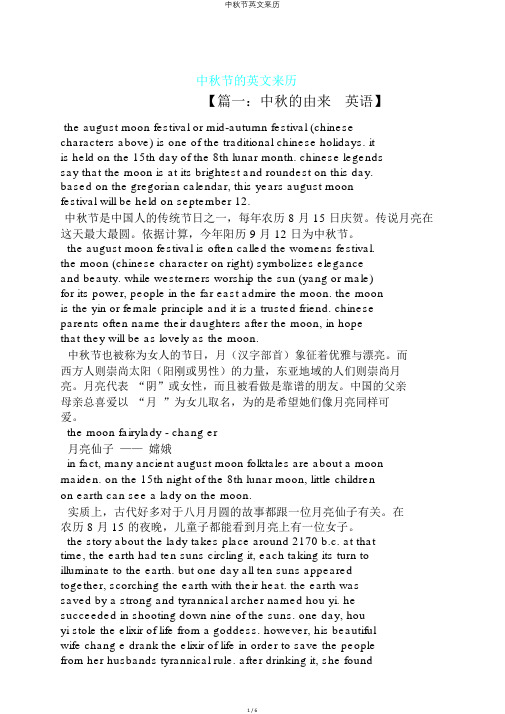
中秋节的英文来历【篇一:中秋的由来英语】the august moon festival or mid-autumn festival (chinesecharacters above) is one of the traditional chinese holidays. itis held on the 15th day of the 8th lunar month. chinese legendssay that the moon is at its brightest and roundest on this day.based on the gregorian calendar, this years august moonfestival will be held on september 12.中秋节是中国人的传统节日之一,每年农历 8 月 15 日庆贺。
传说月亮在这天最大最圆。
依据计算,今年阳历 9 月 12 日为中秋节。
the august moon festival is often called the womens festival.the moon (chinese character on right) symbolizes eleganceand beauty. while westerners worship the sun (yang or male)for its power, people in the far east admire the moon. the moonis the yin or female principle and it is a trusted friend. chineseparents often name their daughters after the moon, in hopethat they will be as lovely as the moon.中秋节也被称为女人的节日,月(汉字部首)象征着优雅与漂亮。
中秋节的来历英语版
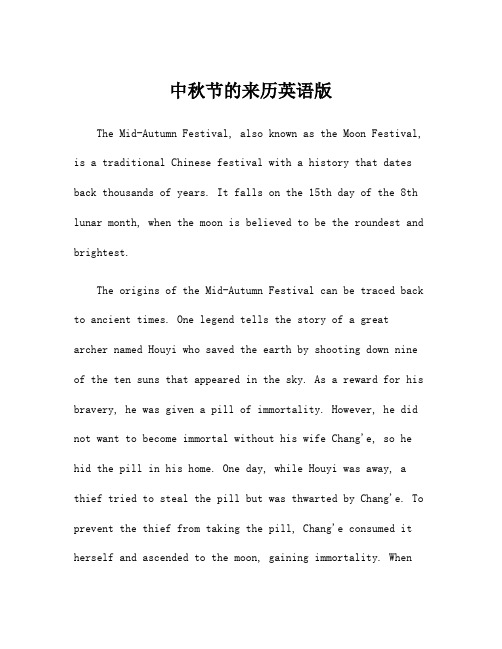
中秋节的来历英语版The Mid-Autumn Festival, also known as the Moon Festival, is a traditional Chinese festival with a history that dates back thousands of years. It falls on the 15th day of the 8th lunar month, when the moon is believed to be the roundest and brightest.The origins of the Mid-Autumn Festival can be traced back to ancient times. One legend tells the story of a great archer named Houyi who saved the earth by shooting down nine of the ten suns that appeared in the sky. As a reward for his bravery, he was given a pill of immortality. However, he did not want to become immortal without his wife Chang'e, so he hid the pill in his home. One day, while Houyi was away, a thief tried to steal the pill but was thwarted by Chang'e. To prevent the thief from taking the pill, Chang'e consumed it herself and ascended to the moon, gaining immortality. WhenHouyi returned and learned what had happened, he offered sacrifices to Chang'e on the 15th day of the 8th lunar month, which became the Mid-Autumn Festival.Another popular legend associated with the Mid-Autumn Festival is the story of Wu Gang and the moon. Wu Gang was a woodcutter who was banished to the moon as a punishment for his arrogance and disrespect. He was tasked with chopping down a self-healing cassia tree, but no matter how hard he tried, the tree would always grow back. This legend symbolizes perseverance and reflects the Chinese belief in the virtue of hard work.Apart from its mythical origins, the Mid-Autumn Festival also has agricultural significance. In ancient times, it was considered a harvest festival, celebrating the abundance of the season. People would offer thanks to the moon for the bountiful crops and pray for good fortune in the coming year. Mooncakes, a traditional delicacy made with sweet fillingssurrounded by a thin, tender crust, are an essential part of the festival. These round pastries are meant to symbolize the full moon and unity.Today, the Mid-Autumn Festival is celebrated by people of Chinese descent all around the world. Families gather to appreciate the beauty of the moon, exchange gifts, and share mooncakes. Lanterns are lit, and dragon and lion dances are performed to add to the festive atmosphere. The Mid-Autumn Festival serves as an occasion to reunite with loved ones, express gratitude, and reflect on the value of family and harmony.In conclusion, the Mid-Autumn Festival is a cherished tradition in Chinese culture. Whether through legendary tales or agricultural symbolism, this festival has deep cultural and historical roots. It brings people together to celebrate the beauty of nature, express gratitude, and strengthen family bonds.。
- 1、下载文档前请自行甄别文档内容的完整性,平台不提供额外的编辑、内容补充、找答案等附加服务。
- 2、"仅部分预览"的文档,不可在线预览部分如存在完整性等问题,可反馈申请退款(可完整预览的文档不适用该条件!)。
- 3、如文档侵犯您的权益,请联系客服反馈,我们会尽快为您处理(人工客服工作时间:9:00-18:30)。
中秋节的来历英文版
The origin of the Mid-Autumn Festival can be traced back to ancient China. It was traditionally celebrated to give thanks for a bountiful harvest and to pray for good luck and fortune. The festival is also closely associated with the legend of Chang’e, the Moon Goddess.
According to the legend, there were once ten suns in the sky, causing extreme heat and drought on earth. The hero, Houyi, shot down nine of the suns, saving humanity from destruction. As a reward, he was given an elixir of immortality. However, Houyi did not want to leave his wife, Chang'e, behind and decided to keep the elixir. One day, while Houyi was out, his apprentice tried to steal the elixir. Fearing the apprentice would succeed, Chang'e decided to drink the elixir to prevent it from falling into the wrong hands. As a result, she ascended to the moon and became the Moon Goddess.
To commemorate Chang'e and her sacrifice, people started to offer sacrifices and pray to the Moon Goddess during the Mid-Autumn Festival. They also began the tradition of making and eating mooncakes, which are round pastries filled with various sweet or savory fillings. These mooncakes symbolize reunion and togetherness, as the festival is often celebrated by families and loved ones gathering to enjoy mooncakes and appreciate the full moon.
Today, the Mid-Autumn Festival remains an important cultural holiday in China and other East Asian countries. People celebrate by enjoying mooncakes, lighting lanterns, admiring the moon, and
organizing various activities and performances. It is a time for families to come together and express gratitude for their blessings while also reconnecting with Chinese traditions and heritage.。
